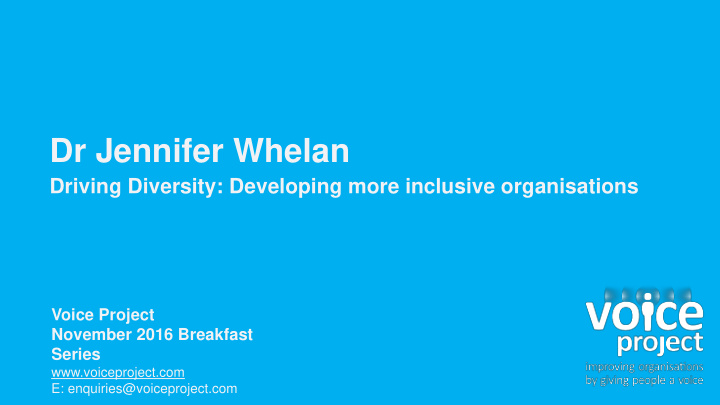



Dr Jennifer Whelan Driving Diversity: Developing more inclusive organisations Voice Project November 2016 Breakfast Series www.voiceproject.com E: enquiries@voiceproject.com
why does diversity and inclusion drive performance? understanding the real business case page 02
the shifting world collective intelligence is of work global village key knowledge is collaboration not networked command and control shared responsibility empowerment automation of (over-) through tech abundant knowledge work data larger more flatter complex hierarchies structures change is the only meaning and constant motivation matter faster paced page 03
diversity or inclusion? diversity inclusion the mix making the mix work inherent leadership demographic group self-aware, curious, agile acquired culture experience, perspective, skills belonging and uniqueness page 04
the business case good for good for the people bottom line happier earnings healthier share price engaged competitiveness committed innovation page 05
i t’s exponential . difference makes us smarter we all perform better in the presence of visible difference
why diversity makes us smarter collaboration problem-solving innovation more questions social learning we think harder more answers increases our we persist longer more information cognitive toolkit we innovate more page 07
if, and only if, the culture values difference difference safe is an asset, not an obstacle to speak up & stand out complementarity divergent is as important as fit views are deliberately sought page 08
the exclusionary default why is inclusion challenging? page 09
unconscious thinking is exclusionary by design superficial patterns & routines gut reactions, generalisations no fact-check or validation faster than logic 90% of the work highly error-prone
common types of unconscious bias similarity bias the familiar = comfort & reassurance confirmation bias seeing expectations = security & confidence groupthink consensus = acceptance & harmony generalisations = simplicity & efficiency stereotypes page 011
so then how do we…? stay open to new ideas from different people? sit with ambiguity and experiment with new solutions? challenge conventions and old habits? flex and adapt to new realities? 012
how can leaders drive inclusion? leading more inclusively page 013
inclusion for leaders 1. identity 2. cognitive 3. inclusive awareness training nudges developing a richer attention & awareness small process perspective on your training and objectivity changes to embed own and other’s “hacks” to manage inclusive practices experience biases normal page 014
behavioural design for organisations reward the right watch your behaviour train, measure and reward language inclusive behaviours language primes our attitudes and behaviour make objectivity easier blind processes, data & algorithms, objective metrics page 015
questions?
Recommend
More recommend